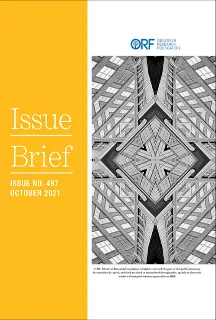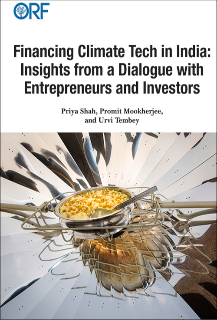Introduction
In the contemporary world of value chains, where the focus has shifted from nations to firms in global trade and commerce, the formulation of trade policies has become increasingly complex. In India, the Directorate General of Foreign Trade (DGFT), under the Ministry of Commerce and Industry, is in the process of formulating the new Foreign Trade Policy (FTP), expected to be rolled out in April 2022 and applicable for the succeeding five years. The drafting process requires tremendous effort in terms of collating and analysing a diverse range of inputs—from export promotion councils, trade associations, industry chambers, commodity boards, and trade policy specialists. Using the results of these consultations, the DGFT must then draft a coherent FTP that takes into account both domestic and international complexities. Moreover, the outcome of the previous FTP[1] must be evaluated to address any gaps and shortcomings in its stated goals. Those included providing a stable and sustainable policy environment and regime; linking rules, procedures and incentives for exports and imports with other initiatives such as Make in India, Digital India, and Skill India; diversifying India’s exports; strengthening the governance architecture for India’s global trade engagements; and correcting the trade imbalance in India’s external engagements.
The global transformation of trade through digitisation has added intricacies in international trade transactions. Therefore, a holistic approach has become more important than ever, and Indian policymakers must shed their tunnel-vision and focus on syncing, streamlining and synergising FTP objectives with other policy initiatives[a] while simultaneously ensuring its compliance, compatibility, and coherence with the global trading system. Thus, significant changes and refinements are needed to make the new FTP suitable at the policy level as well as for Exim operations.
Policy Challenges
The 2020 WTO Trade Policy Review of India[2] noted that India makes extensive use of trade policy instruments such as tariffs, export restrictions, export taxes, anti-dumping duties, and import licensing. According to economist Arvind Panagariya, such tools create uncertainties and induce distortions in the international trading system.[3] Further, since most policy changes are introduced through circulars and notifications, they disregard the trade policy objectives stipulated in India’s five-year FTP document. The recent introduction of tariffs, restrictions, and strict regulatory compliance on imports has made India’s trade policy the most restrictive that it has been. For example, in 2019, India imposed restrictions on the importation of 101 defence items and classified many commodities in the “restricted category” under Schedule 1 of the import policy.[4] The new FTP must address these concerns.
There is mounting multilateral pressure for India to rationalise export promotion schemes[b] to make them compatible with WTO norms. However, the MEIS was discontinued in January 2021, with far-reaching implications for India’s export competitiveness, since the benefits of the scheme were widely used by MSMEs to offset infrastructural inefficiencies and associated freight externalities.[5] Instead, the Government of India has announced duty neutralisation rates under the Remission of Duties and Taxes on Exportable Products (RoDTEP), which will refund embedded duties and taxes not refunded earlier, such as fuel, stamp and electricity duty, including those implemented at the state and local levels. It is important to note that the RoDTEP is not a replacement for the MEIS: the latter was an incentive scheme, while the RoDTEP is a refund of duties and taxes that exporters have already paid, i.e. the exporters’ own finances. The Union Budget 2021–22 has allocated INR 13,000 crore for the RoDTEP. Across 12,000 tariff lines, the net refund will thus be approximately one percent of the Free on Board (FOB) value. This will further vary across products, depending on the methodology being used to incentivise products with high employment potential, export values and export intensity.
The upcoming FTP can play an important role in making India a competitive exporter, by mobilising international investment to boost manufacturing exports and fostering greater synergy in trade and investment. In practice, India has significantly liberalised its foreign investment policies and allowed FDI up to 100 percent, across sectors such as defence, broadcasting carriage services, agricultural activities, telecommunication services, insurance and intermediaries, business-to-business electronic commerce, and airport and non-scheduled air transport services. However, this liberalisation is not backed by policy. Indeed, the trade policy regime has become more restrictive since 2014, under compulsion from the evolving global economic order. Between 2014 and 2019, import tariffs increased from 13.3 percent to 17.6 percent on average, from 9.7 percent to 13.6 percent on industrial goods, and from 36.3 percent to 43.02 percent in agriculture.[6]
In particular, the introduction of the Goods and Service Taxes (GST) in 2017 caused a substantial jump in import tariffs. Additional Duties and Special Additional Duties (SAD) previously added to the basic import tariff were removed, and the IGST levy introduced in lieu of the Countervailing Duty (CVD). The 10-percent Social Welfare Surcharge, which applies only to imports, remains in place. A study by Subramanian and Chatterjee found that the increase in import tariffs over the past six years has impacted trade worth US$300 billion, i.e. approximately 70 percent of total imports of the country.[7]
To be sure, liberalising FDI policies while simultaneously increasing import tariffs creates a discordance that affects India’s ability to foster strong trade and investment linkages. Moreover, it discourages export-oriented foreign direct investment (FDI) in the country, undermining possible opportunities to plug the missing links in global value chains. At the same time, a country must often make difficult choices based on geostrategic, geopolitical and geoeconomic reasons—including, for instance, how long India should remain import-dependent for electronics, electrical, defence equipment, and speciality steels, among others. The new FTP needs to address these asymmetries keeping in mind other policies that are critical for the growth of trade and investment.[8] Policymakers must work on these issues to balance both domestic and international concerns, protecting the domestic industry in critical areas with policy interventions such as the Production Linked Incentive (PLI) and simultaneously aiming for export promotion by participating in the global value chains.
From 2004 to 2011, India signed 11 Preferential and Free Trade Agreements (FTAs), but none thereafter. It is time for the country to formulate a new strategy for its regional and bilateral trade agreements, especially given the growing number of FTAs in Asia for external engagements. In 2020, the government opted out of joining the mega-FTA, Regional Comprehensive Economic Partnership (RCEP), on the grounds that India’s core concerns are yet to be resolved.[9] Although India has been negotiating bilateral trade agreements with the European Union, Canada, Israel, Australia and New Zealand for a long time, none of them has yet been finalised—indicating India’s reticence towards regional and bilateral trade agreements in the context of its learnings from existing FTAs and its ever-increasing trade deficit.[10]
The new FTP must provide policy guidance and a direction for future trade agreements. The benefits of FTAs must be strongly communicated to the industry, so that it can prepare itself for future trade deals. Moreover, the FTP should highlight the importance of data collection for utilisation rates of FTAs—both on imports and exports. India’s future external engagements should be focused on either signing FTAs with the consumption economies (the US, EU, Britain) or having access to low-cost raw material, inputs and intermediate, to enable the production of goods for export; e.g., sectoral FTAs in sectors where India has competitive advantage. India can further explore avenues for tapping trade opportunities with leading economies using services FTA.
The rapid digitisation of global production, trade and consumption of goods and services has had a profound impact on the trade competitiveness of countries, fuelling the need for robust digital skills, infrastructure and capabilities. This is one of the key areas where India is lagging behind other developing countries such as China and South Africa, e.g. India’s exports of technological goods and services.[11] The government must work on building its digital capabilities and infrastructure in key export sectors through a ‘Digitally Informed Foreign Trade Policy’, with a focus on enhancing India’s trade competitiveness by developing digital infrastructure for trade; building digital skills in tradeable sectors; increasing the share of technology content in exports; and leveraging advanced technologies (Big Data Analytics, IoT, and Blockchain) for evidence-based and informed trade policy decisions.[12] Further, these efforts must be aligned with the country’s domestic and multilateral trade negotiations. To that end, it is critical to preserve the policy space in its regional and multilateral trade negotiations, in key areas such as data localisation and cross-border data flows.
Operational Challenges
At the micro-level, there is significant scope for improving the overall foreign trade ecosystem to ease the burden on international trade operations. Policies pertaining to export-import operations need to be fine-tuned according to the evolving global trade realities. Industry Associations and Export Promotion Councils are now demanding a change in the Indian Trade Classification from eight to 10 digits, since most countries already follow the 10-digit tariff nomenclature. The current discrepancy creates documentation ambiguity and confusion for Indian exporters while exporting goods to developed countries. For example, there is no HS code for coir mats, which constitute around 53 percent of India’s total coir exports and whose value amounted to over INR 2,700 in 2019. Similarly, there is only one HSN for all sweets exported from India (ITC-HS 21069099); Bengali Rasgulla, for instance, has a Geographical Indication (GI) tag but no unique HS code. Moreover, tariff classification at 10 digits usually incurs a lower import duty because of the highly disaggregated product classification. Without it, India’s exports are subject to higher duties in the developed market. The new FTP should address this issue, and the biggest challenge will be ensuring effective coordination between the three regulating bodies—the DGFT, the Customs and the GST Council.
The EPCG Scheme, designed to act as a stimulus for exports, allows access to superior technology through the import of capital goods at zero duty, subject to the fulfilment of export obligations in a mandated timeframe. The EPCG is WTO-compliant and should be continued: it offers access to high-technology capital goods, enabling Indian manufactures to produce quality goods for both domestic consumption and export, subject to the fulfilment of export obligations. However, the scheme involves a labyrinth of conditionalities: first, to avail of this authorisation, an average export turnover of three years is factored; second, the mandated export obligation must be over and above the average export turnover of the last three years; third, 50 percent of the export obligation must be completed in the first four years and the remaining, in two years; fourth, the EPCG licence will be deemed issued from the first of the month regardless of the actual date of issuance.
Furthermore, since two agencies are involved—DGFT, which issues EPCG authorisation; and Customs, which monitors it—each with their own policy framework, circulars, and notifications for compliance, more clarity is needed on the applicable exchange rate, terms of redemption, and conditions for consolidation of authorisation. Industry has expressed the need for EPCG authorisation to be more user-friendly, especially for deemed exports, to support the Atmanirbhar Bharat Abhiyaan by encouraging the sourcing of capital goods from the domestic industry. The new FTP should therefore address the operational challenges faced by exporters in availing the EPCG licence.
India’s policymakers have always insisted that goods should be exported, not the taxes. However, effective duty neutralisation in policy as well as in practice requires making Indian goods competitive in international markets. There are three levels of taxes in India: Central, state, and local, of which only Central had been neutralised in the export chain so far. The newly introduced RoDTEP, albeit not exhaustive, is a comprehensive scheme to neutralise the taxes at the state and local levels as well. However, this does not include “cess and levies,” which has emerged as a potent instrument in recent years, to collect funds for designated purposes. India’s existing manufacturing landscape offers proliferated duty neutralisation schemes to units located in Special Economic Zones (SEZ), Dedicated Export Enclaves (EOUs/BTPs/STPI), Manufacturing under Custom Bond (Section 65, Customs Act 1962),[13] and Domestic Tariff Area.
There is a need for policy rationalisation to level the playing field under each type of manufacturing. One way of reducing import-dependence and facilitating enhanced export can be to allow Domestic Tariff Area (DTA) sales to SEZ units in select areas where India has higher import-dependence, subject to the payment of taxes and duties on such sales. This will facilitate manufacturing units to scale up faster in tax-neutralised zones. Further, duty neutralisation through advance authorisation and the EPCG Scheme should be aligned with India’s national economic policies to encourage and incentivise domestic sourcing.[14] Therefore, a core focus of the forthcoming FTP should be to encourage industries with zero or lower-carbon footprints, women entrepreneurs, start-ups, and export beyond IT and IT-enabled services. Domestic manufacturing should also be incentivised for deemed exports through required policy rationalisation, linking them with the export-oriented industries or sectors, if they can offtake directly in the export market in the initial years.
For the expansion and diversification in foreign trade, the GoI must assess the demand for key products in the global market, to ensure export volumes, values, scale and intensity. The new FTP should incorporate a plan to identify the key sectors with import demand. As of 2019, the key imported products in the world market were electrical machinery (15.19 percent), mineral fuel (12.26 percent), machinery and appliances (11.95 percent), vehicles (7.95 percent), diamonds and precious metals (3.44 percent), pharmaceuticals (3.42 percent), plastics (3.33 percent), medical and other devices (3.22 percent), organic chemicals (2.32 percent), and iron and steel (2.02 percent). Since India is heavily import-dependent for many of these key products, a push to scale up these industries using the right production and trade incentives will serve two purposes: first, it will reduce import-dependence; and second, it will help India tap into the global market with cost-competitive and quality exports.
Furthermore, India’s domestic policy action for promoting export must be based on external requirements. For example, India’s “One District–One Product” (ODOP) Scheme can be used to develop and scale up the industries around some of these key importable products in the world market.[15] Keeping in mind that what is marketable is sellable, but what is sellable is not necessarily marketable, the GoI must ensure that the Scheme serves its utility in content as well as substance. Indeed, some traditional products with high labour content can be included in the ODOP Scheme as envisaged.
Finally, achieving superlative growth in foreign trade requires target policy action both at Central and state levels, to develop upstream industries (low-cost steel, API & Excipient, Chemical Hubs), skilled personnel, and world-class logistics infrastructure to address the associated redundancies. Therefore, Indian states must become active partners in India’s external engagements, and the FTP should reward some of the thrust sectors for exports through policy support, in sync with the desired policy interventions of individual state governments.
Conclusion
In drafting the new Foreign Trade Policy, the office of the DGFT must ensure alignment with globally acceptable policy norms, introduce policy measures for addressing the operational problems faced by the trade community, fine-tune the existing policies to match contemporary business requirements, and take into account India’s macroeconomic policy framework. At the same time, policy initiatives must be aimed at creating synergy within the overall policy framework as well as with the prevailing global economic and trade landscape.
Going forward, policymakers must double down on the merits of free and fair trade, since trade benefits all, and work towards providing a level playing field to both domestic and foreign producers, to manufacture in India and export to the world markets. The upcoming FTP will address the challenges of emerging India through required policy interventions for green industries, start-ups, women entrepreneurs, and services sector exports. To this end, the key deliverables of the policy must be inclusive of the ambitions of an evolving India—fulfilling the growing demands of the country’s agricultural, manufacturing, and services sector while also creating a multiplier effect in the economy through enhanced trade.
About the Authors
Ram Singh is Professor and Head (Training/MDP), Indian Institute of Foreign Trade, under the Ministry of Commerce and Industry, Government of India, New Delhi. Email: [email protected].
Dr Surendar Singh is Deputy Director at KVIC, Ministry of MSME. Email: [email protected].
Views are personal.
Endnotes
[a] The most essential ones being Make in India, Self-Reliant India, Digital India, and Start-up India.
[b] These include the Merchandise Export India Scheme (MEIS), Export Promotion for Capital Goods (EPCG), and Interest Equalisation Scheme (IES).
[1] Foreign Trade Policy 2015-20, Directorate General of Foreign Trade.
[2] World Trade Organisation Trade Policy Review for India, 8 January 2021.
[3] Arvind Panagariya, “Don’t resurrect failed policy: Why import substitution industrialisation is doomed to flounder, again,” Times of India, July 22, 2020.
[4] “101 weapons identified for indigenisation under Atmanirbhar Bharat Abhiyan,” The Hindu, September 17, 2020.
[5] “India loses export incentive case filed by US at WTO, to appeal against the ruling,” The Economic Times, November 1, 2019.
[6] “India implemented several measures to facilitate trade during 2015-20: WTO,” The Hindu, January 7, 2021.
[7] A. Subramanian. and Chatterjee, “India’s Export-Led Growth: Exemplar and Exception,” Working Papers 42, Ashoka University, Department of Economics, 2020.
[8] “Relooking India’s Tariff Policy Framework,” Export Import Bank of India, Special Publication, 2020.
[9]N. Ghosh, “The RCEP clamour and India’s priorities,” India Today, November 23, 2020.
[10] Prachi Priya and Aniruddha Ghosh, “India’s Out of RCEP: What’s Next for the Country and Free Trade?” The Diplomat, December 15, 2020.
[11] R. Banga, “Is India Digitally Prepared for International Trade?” Research for Information System for Developing Countries, Discussion Paper #235, 2018.
[12] R. Banga, “Is India Digitally Prepared for International Trade?”
[13] Customs Act 1962, Central Board of Indirect Taxes and Customs.
[14] “World would benefit from a self-reliant India: Modi,” The Hindu Business Line, January 31, 2021.
[15] S. Dhingra, “1 District, 1 Product’ export scheme, farm reforms on govt, NITI blueprint to push growth,” The Print, 2021.
The views expressed above belong to the author(s). ORF research and analyses now available on Telegram! Click here to access our curated content — blogs, longforms and interviews.

 PDF Download
PDF Download



 PREV
PREV



